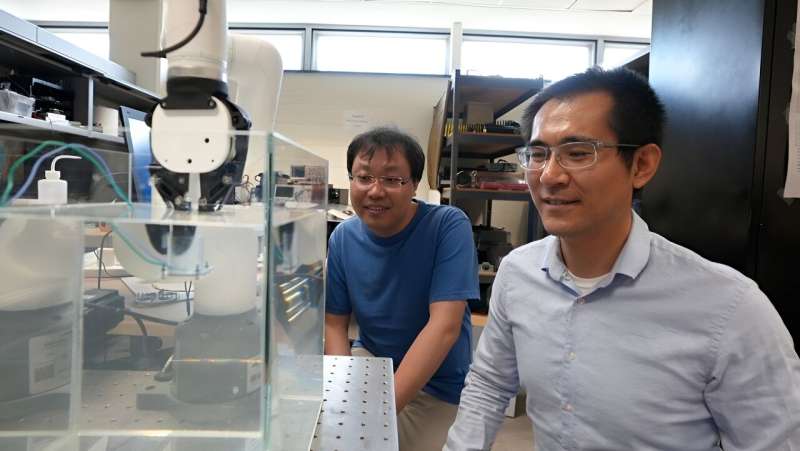This article has been reviewed according to Science X's editorial process and policies. Editors have highlighted the following attributes while ensuring the content's credibility:
fact-checked
peer-reviewed publication
trusted source
proofread
New surgical tool moves tiny bioparticles with robotics and acoustic energy

Undergoing surgery is seldom a pleasant experience, and it can sometimes be highly invasive. Surgical procedures have evolved steadily over the centuries, growing with the knowledge of anatomy and biology.
Innovative methods have also been bolstered with new tools, and a growth in the use of robotics since the 1980s has moved health care forward significantly. Assistant Professor Zhenhua Tian has pressed forward another step in the march of progress using robotics and noninvasive acoustics, and his team's work has been published in Science Advances.
Robot-assisted surgery
Surgery using robots has been invasive since its invention because cutting is involved and often other instruments are inserted into the incision. However, because robotic-assisted tools can be smaller, the cuts also tend to be smaller than traditional surgeries, making robotics a preferred choice. This form of surgery has proven its benefits and has grown in use over time, with advantages to patients including
- Less discomfort and bleeding
- Less time in the hospital
- Faster recovery periods
In fact, according to the American College of Surgeons, 1.8% of surgeries included a robot in 2012. By 2018, that percentage had risen to 15.1% and continues to rise through advancements in robotics. Some of the most common procedures involving robotics include appendectomies, hysterectomies, and gastric bypasses.
Noninvasive sound treatment
While robotic-assisted surgery has its share of advantages, Tian's team has taken that idea a step beyond its current state: Team members are developing a method of moving small targets, such as cells and medicine, within a body that is noninvasive. That means the method requires no cuts.
The secret is found in acoustic energy emitters that Tian's team uses to surround and capture particles, working like invisible tweezers. The emitters create 3D acoustic vortex fields that can pass through barriers such as bone and tissue, crossing over one another to form tiny ring-shaped acoustic traps. Micro- to millimeter-sized objects caught at the center of an acoustic trap can be moved and rotated.
"The ability to move cells and drugs around inside veins without breaking the skin creates new opportunities in medicine," said Tian. "As we continue the work on this research, I anticipate we will find a host of new applications."
By mounting an acoustic vortex emitter onto a robotic platform, the acoustic vortex beam can be moved at the micrometer scale. Accordingly, the particle trapping area can be precisely set in a 3D space, and moving a particle after its capture can be engineered. When moving a tiny object along the winding path of a blood vessel, this can be a critical feature.
More than medicine
While Tian's team is able to move a small object behind a solid structure, the acoustic vortex beams can move particles within both gases and liquids as well. Although the current approach targets small particles within those substances, integrating the acoustic energy emitters together with robotics has applications beyond surgery and very small particles. Contactless, robotic manipulation has potential in many other applications across engineering, biology, and chemistry research. Some of those include
- Controlling microrobots
- Handling delicate bioparticles, such as exosomes and cells
- Transporting hazardous reagent droplets
- Controlling self-assembly of colloidal materials
- Arranging nanomaterials for composite fabrication
"When we were recently participating in a STEM expo, the children who visited us enjoyed putting small beads into the invisible acoustic fields generated by our devices, but we would like to offer the opportunity for them to move larger objects," said Tian. "Next year, we hope to have a larger emitter that can hold a ping pong ball. It will be interesting to see how we plug that approach into our other research."
More information: Teng Li et al, Robot-assisted Chirality-tunable Acoustic Vortex Tweezers for Contactless, Multifunctional, 4-DOF Object Manipulation, Science Advances (2024). DOI: 10.1126/sciadv.adm7698. www.science.org/doi/10.1126/sciadv.adm7698




















